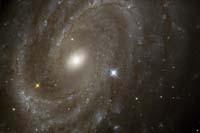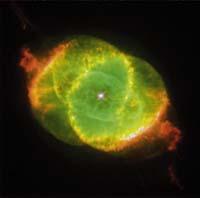Matter not visible
01/10/2006 | Lasa Oiarbide, Aitzol | Elhuyar Zientzia Komunikazioa

Bright eye.
ANDÉN
Although no one knows what it is, there is a reason for astronomers to use the concept of dark matter as bolo. In fact, dark matter is used to explain facts that cannot appear otherwise.
For example, due to its rapid rotation speed, some galaxies would be dispersed according to current theories. Somehow, its mass is not enough to withstand the material that rotates at that speed. The idea of dark matter serves to explain these facts: there is a matter that we do not see, therefore dark, that provides these galaxies with a sufficient mass not to disperse them.
Other galaxies, called nana galaxies, although they do not have a rapid rotation, have little visible mass. This mass could not generate enough gravitational force and the galaxy would be dispersed. But it can be assumed that there is matter that is not seen holding the cloud. In the case of dwarf galaxies, the missing matter should be 30 times the Sun.
In short, to explain the effects of the gravitational forces present in the universe, in general, lack matter. That matter lacking in the universe is dark matter, which is missing for everything to go well.

Dark matter is 80% of the mass of the universe. Although it is not seen, the dark matter is there.
ANDÉN
Looking for dark matter
To explain the gravitational forces that occur in the universe, it is necessary, therefore, to go in search of dark matter. And, if there is matter of this type, you will first have to know where it is.
In February last year they found in the set of stars of Virgo a galaxy formed by dark matters. At first they found the hydrogen cloud and supposed it could be a dwarf galaxy, so they did not see it. However, after analyzing how hydrogen was moving, astronomers realized that it should have a mass greater than it seemed. But then the cloud would have enough mass to turn on the stars and could be seen with an amateur telescope where no stars appeared. However, if it is supposed to be a galaxy made up of dark matter, the gravitational fields around the cloud can appear smoothly.

By its huge speed, the Excluded Star has taken the path of leaving our galaxy. This allows astronomers to analyze their interaction with dark matter.
ANDÉN
Studies of this type indicate that dark galaxies are more abundant than conventional galaxies. Another hypothesis is that dark matter surrounds conventional matter thanks to its gravitational influence, so it is of vital importance when creating stars and other stars.
Fast stars to analyze dark matter
Also in February last year, astronomers found a star at 700 km per second. Although stars cross the space at high speed, this speed is huge for a star. It is twice the speed that a milky track star needs to leave the orbit, which is what will happen to the Rejected Star, which has given it that name. It goes so fast that it goes directly from our galaxy out. The Excluded Star is not the only one to abandon the Milky Way, astronomers have catalogued about 10,000 stars of this type, but the Discarded Star has the speed record.
The extraordinary speed of the Marginalized Star is an advantage for astronomers by the influence of their gravitational interactions with other stars. When passing near a star it will deviate. But it will also suffer inexplicable deviations, which now slows down and now accelerates. In this way, one can analyze the influence of dark matter, which is not seen.
The lens of gravity also allows us to analyze the dark matter

It is difficult to say anything about dark matter because it has no visible properties.
ANDÉN
In the wake of dark matter there is another cosmic effect that can be useful, the effect of the lens of gravity. The gravitational force that generates the mass of a galaxy returns the light that passes to its side, that is, gravity makes the effect of the lens. The estimate of the torsion that suffers from light allows to know the influence of the mass of dark matter on torsion and, therefore, to calculate the same mass of dark matter. It is believed that the mass of dark matter is 80% of the mass of the universe, while in the case of the Milky Way this proportion is 90%.
The extension of the lens of gravity is of the order of 1%, being adequate the quasars to study this cosmic increase. In fact, the quasars are luminous and, as they are very far away, their light suffers the lens of gravity of many cosmic objects before reaching the Earth.
Properties of dark matter
So far it has been seen that in the universe there is something called dark matter and whose existence is demonstrated by the interactions of gravity. And if it exists it will have properties. But what are they?
Dark matter seems too fleeting to obtain direct information about it. No electrical charges, magnetism, or interactions with light or radiation have been found. Considering these properties -- these disproperties -- it seems difficult for astronomers to learn more about dark matter. Not much less.

The light is twisted by passing by a galaxy, because the gravity field of the galaxy also attracts waves. The knowledge of the torsion of light allows to calculate the mass of the galaxy and hence the proportion of dark matter of the galaxy.
ANDÉN
To justify the existence of dark matter, astronomers have used dwarf galaxies with which it seems logical to be able to extract more information. To begin with, they have deduced that the velocity of dark matter of nana galaxies is 9 km per second. From this speed the cloud that forms the dwarf galaxy would disperse, while below that speed the cloud would be compacted. With this information, and by pulling the string of physical equations, it can be concluded that the temperature of the dark matter is 10,000 °C.
This seems like a relatively high temperature for a matter that does not generate any type of light. According to the first hypotheses, dark matter necessarily needed cold. But the hypothesis of cold dark matter posed many problems. Among other things, small galaxies should be orbiting larger galaxies and this type of cosmic structures has not yet been found anywhere. The hypothesis of hot dark matter, on the other hand, does not present this type of deficiencies.
Dark energy dark energy
Once the existence of dark matter is justified, and after mentioning some of its properties, we can analyze the hypotheses of origin of dark matter. For this, it is essential to enter the field of quantum physics and mention black holes. One of the hypotheses is that black holes are stars of dark energy. The idea that the universe is expanding is something accepted among astronomers and the hypothesis is that dark energy is responsible for this expansion.

One way to find cosmic objects that are not seen is to analyze gravitational interactions between masses.
ANDÉN
According to the hypothesis, the black hole exerts enormous gravity on the outer matter. However, within the black hole, the matter is transformed into antimatería and is again expelled to the outside. Materials and antimaterías are destroyed and released high energy radiation. That would be the source of the radiation that is generated in the centers of galaxies.
In addition to black holes, the hypothesis says that there should be other dark energy stars, called fundamental. The latter would not occur as traditional black holes -- black holes are a consequence of the collapse of the stars -- but through space-time fluctuations. Somehow, just as in a cloud of water vapour the drops of water are condensed, in quantum space-time stars of dark energy are also formed. These stars would generate the severity of the usual ones, but they would be invisible. That is, it would be formed by dark matter.
Intention to create dark matter in laboratory
It seems that although its influence on space can be seen, it will be very difficult to find the dark matter itself through a telescope. And as it will be difficult to find it in space, they are conducting other experiments to find dark matter. For example, at the University of Zurich they have performed simulations through a supercomputer and have concluded that in the Milky Way there are 10 15 halos of dark matter. This means that the Earth crosses one of these halos every 10,000 years.

The Geneva CERN laboratory will attempt to artificially generate dark matter. To do this, the LHC particle accelerator is being built.
ANDÉN
But, in addition to performing simulations, scientists are also thinking about creating dark matter in the laboratory. To do this, they intend to create in the laboratory a subatomic particle called neutralin, which is one of the candidates for the generation of dark matter. Neutralin has never been detected, but the theory of supersymmetry suggests its existence and determines its mass and how it can occur.
Neutralin is the antiparticle of itself. This means that two neutralins are destroyed when colliding. In this shock, gamma rays are produced. However, this type of explosions are rare. The LHC particle accelerator, which is being built at the CERN laboratory in Geneva, is expected to serve the generation of neutralines and other supersymmetric particles, and to be available in 2007.
Rafael Rebolo: "At this moment, the main challenge of cosmology is to understand the origin of matter and dark energy"
Rafael Rebolo, physicist and doctor in Astrophysics. He works at the Instituto de Astrofísica de las Islas Canarias. He has published numerous works, has received numerous awards and has obtained great prestige in the scientific community. Talk at the congress Annus Mirabili of San Sebastian. He spoke of the origin of life, since he has directed several projects on the origin of the elements. More appropriate than him to speak of dark matter.
To understand the universe, cosmologists have invented the concept of dark matter.
The best example to understand how the evolution of the universe is is the Big Bang. However, despite being the best, this model has components that we do not understand very well because we have not been able to know the origin of all things in the universe. These components have been given a rather exotic name, such as matter and dark energy. To understand well the observations we make, we must integrate these components into the model. Although it seems the opposite, it does not reverse the model. An interesting combination is the field that establishes the model and components that we still do not know at all. We need more resources to experiment with explanations about one and the other or about both.
And what is believed to be dark matter and energy?
Dark matter would be the most abundant matter in the universe, but we still do not know its origin. When we speak of common matters we know that at the base there are atoms, with their nuclei, with their electrons and with the components of the nuclei. When we talk about a planet like ours or a star, we know, in general, what matter is made. However, clues and evidence suggest that other forms of matter exist in the universe. We cannot characterize them because in the laboratories we do not get enough energy, while on the cosmic scale the influence of this type of matter is evident, it is noted.
Yes, but what is believed?
The main candidate to be part of dark matter would be a basic particle that would exist if some of the theories that unite basic forces were fulfilled. This particle would have a much larger mass than protons, perhaps 100 times greater, but the way to interact with the rest of the matter would not be the usual one. It could not form an object like the one we take with our hands or an astro like the one we observe. This type of interaction is called weak interaction, since the way of interacting with matter is weak. This means that we could not recognize it, despite the great mass. That is why it is difficult to find it: it has mass, but it has another relationship with matter. Surely from there we would learn many things!

(Photo: B. B. Windbreak)
Is that the only option? Would it be impossible, for example, that any of the theories we now have were wrong?
One of the options is to have a problem with one of the fundamental laws of nature, specifically the Law of Universal Gravitation. The other option is that what is being done is to have a new form of matter that some physicists are announcing. The truth is that we have no experimental elements to say which particles are, we have not been able to know yet how the particles that form that matter are. In any case, it will be interesting and we will be winning, that is, allowing us to better understand the universe, either because we will know better the origin of forces or particles.
Is dark matter one of the challenges of cosmology?
Yes. At this time, the main challenge of cosmology is to understand the origin of dark matter and energy, basic components of the universe. I say basic because without these components we cannot understand well some of the observations we make. From there we don't know anything, we have clues to think that they exist, but we can't say what they are and that's why they are a great challenge. They are something similar to the summit of the iceberg. We see something that is above the sea, but what is behind will probably be bigger and we will find it little by little.
Deadline to respond to these challenges?
We are in a very interesting moment. To my XVII. I like to compare with the nineteenth century. Astronomers then began to understand what planets and physicists are, such as Galileo, Copernicus, Newton and Kepler, how the world is organized. The cosmos of that time, with the resources they then had to study nature, was our solar system. Today we have the means to go further and ask for the origin of all this. And we make theories. They made the Law of Universal Gravitation and we do not know if in the coming years we will give a new law of Physics. I like to think that we are going to give. In any case, we will gain knowledge and access to knowledge is beneficial to everyone.
Beñardo Kortabarria
The technique for finding dark matter is not new
"The beautiful star makes it clear/only in the high sky/not alone, has friends/Lord the sky." As the old ballad of Biscay commands, in the sky there is not a single star, but many. Quantifiable are only those that can be seen from our planet Earth, but they are many. Others are not seen at first sight, or through an optical telescope, because they are too far or because they emit little light, but the mind of man discovers them through astronomical measurements.
To find stars that are not seen, you first need a lot of information about the stars that are known, and to obtain that information the telescopes are necessary. The telescope analyzes the spectrum of electromagnetic waves emitted by a star. From this spectrum you can know the speed, direction and mass of the star.
The stars have huge masses that interact gravitational with each other. Sometimes, a star does not have the speed or trajectory that corresponds to it according to empirical data. In these cases, there seems to be a mass that is not seen that, through a gravitational interaction, shapes the trajectory of the star. It is a way to find a star that is not seen there.
Similar techniques should be used to collect data on dark matter, since this is an unvisible matter.
Lasa Oiarbide, Aitzol
Services Services Services
224
2006 2006 2006 2006 2006
Services Services Services
037 037 037
Physics Physics Physics
Article Article Article
Services Services Services


















